Marine Life Society of South Australia
Inc.
Newsletter
April 2006 No. 331
“understanding, enjoying & caring for
our oceans”
Next Meeting
This will be the April General Meeting and will be held at the Conservation
Centre, 120 Wakefield Street, Adelaide on Wednesday 19th April commencing at 7.30pm.
Our speakers will be:
Tony & Judith Wingate (with Tony & Phyll
Bartram) from KI Community Education.
Tony and Judith Wingate, Consultant Marine
Biologists, will give a presentation on the Marine and Environmental Programmes
at Kangaroo Island Community Education and will have a shortish datashow to
present.
CONTENTS
The Weedy Seadragon and its Protection (Philip Hall)
Some Of SA’s Long Lost Jetties (Part 3) (Steve
Reynolds)
Membership Renewals
If you have not already renewed your membership then
Phill would appreciate payment soon for the 2006-2007 financial year. The usual
membership form is missing from this Newsletter as I needed the space for an
article. If you need one then please download one from our website.
Committee Nominations
In order to publish the committee nominations in
the May Newsletter as required by our Constitution I will need them by 12th April at the latest. As usual present Committee Members only need to nominate
themselves. Others will need a seconder.
Nominations for non-executive positions will be
taken on the night.
The Weedy Seadragon and its Protection
For several years we have had the following
message on our website in the “Issues” section.
MLSSA Web Page Topic
Now that the focus of our previous issue has reached a successful
conclusion, it is time to move on to the next issue. Previously we wanted to
have the Leafy Seadragon adopted as the South Australian fish logo. The former
State Government adopted the Leafy Seadragon to represent SA.
Our new focus concerns the protection of Weedy Seadragons in SA waters. The
Weedy has not been afforded the protection given to the Leafy Seadragon even
though it appears to be less common in our local waters.
Slow-swimming fish such as the Weedy, once discovered, may easily be caught
or harassed. The protection given to Leafies may inadvertently create more
interest in Weedies, making them more vulnerable.
We call on the State Government to formally protect the Weedy and ensure
that we encourage these visitors to our waters by admiring them from a short
distance. If they are left alone they may become more visible and their numbers
could swell to a reasonable level.
The Victorian Government has now announced plans to declare the Weedy its
Piscal emblem and this too will focus more attention on the creature.
The following picture of a
Weedy Seadragon is taken from our Photographic Index.
The Photo Index can also
be viewed on our web page.

There followed a plea for
everyone to assist by petitioning the relevant Ministers, Departments and the
Premier.
Then Margaret and I on behalf of MLSSA were invited to a community meeting
on 6/9/05 to voice any concerns we may have had to the relevant Ministers. I
was able to talk to Rory McEwan, the Fisheries Minister and to the Premier,
Mike Rann, about the Leafy Seadragon. The Premier listened carefully and then
went to the podium and announced that legislation would be enacted to protect
the Weedy Seadragon because of representations by the Marine Life Society. I
then placed he following note on the website.
Because of representations today (6/9/05) by
Philip and Margaret Hall direct to the Premier and some of his Ministers at a Community
Meeting, the Premier Mike Rann announced there and then that Protected
Status is to be given to the Weedy Seadragon.
16/2/06
The following press release has now been published.
Hon Rory McEwen
Minister for Agriculture, Food
and Fisheries
Minister for State/Local
Government Relations
Minister for Forests
Thursday, 16 February 2006
STATE GOVERNMENT TO PROTECT SEA
DRAGONS AND SEA HORSES
The
Rann Government has moved to deliver greater protection for sea horses,
pipefish and weedy sea dragons in South Australian waters by declaring them
protected species, like the leafy sea dragon.
Agriculture,
Food and Fisheries Minister, Rory McEwen said today the decision reflected a
commitment by the Premier at a Community Cabinet meeting last year to protect
the weedy sea dragon.
“It
also follows a report by the Australian Institute of Criminology that concluded
seahorses are vulnerable to organised criminal exploitation and without
adequate controls, the viability of stocks may be placed in jeopardy,” Mr
McEwen said.
“Sea
horses, pipefish and weedy sea dragons are some of the most admired creatures
in our local waters and they have become a tourist icon.
“The
least we can do is protect our wild population from exploitation and make sure
that S.A. waters remain a haven for the much loved marine life to flourish.
“Our
protection will mean that the animals can’t be taken from our waters, however
rare exemptions can still be issued for research and development activities
such as those by the Port Lincoln Seahorse Farm and University researchers,” Mr
McEwen said.
“Changes
to the Fisheries Act regulations have declared the Family Syngnathidae, which
includes sea horses, pipefish and sea dragons, protected species.
“The
most notable of these species is the rare leafy sea dragon which was heavily
poached for home aquariums in the late 1980’s and subsequently declared a
protected species.
“Leafy
and weedy sea dragons are closely related species occupying similar
environments and habitats with both being listed on the International Red List
of Threatened Animals.
“Certain
species of pipefish, sea horses and sea dragons have been targeted for use in
the Asian apothecary trade. The most sought after species are tropical sea
dragons, which can grow up to nearly half a metre in length.
“The
species found in South Australian waters are not heavily sought after for this
trade, but conservationists are concerned that their over exploitation in
tropical waters may cause a shift in focus to local temperate waters.
“As
a result of these concerns, we decided to act now to strengthen the degree of
protection over these animals to ensure they’re around for a long time to
come,” Mr McEwen said.
I consider this a victory for the Marine Life Society and
now ask members to suggest a new Issue for us to pursue
Some Of SA’s
Long Lost Jetties (Part 3)
SA’s First Jetty
Picture credits: (SR) = Steve Reynolds (NR) = Noeleen Reynolds
Old Brighton Jetty
Brighton’s first
jetty was built between 1st October1885 and 30th April1886.
A Richard Honey had won the tender to build the jetty. It was all timber and
was 206m long and 4.2m wide. It was 3.5m above sea level.
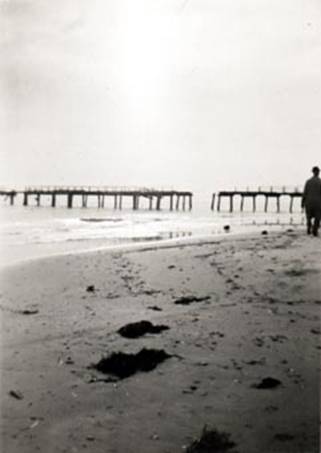
Photo of the storm-damaged Brighton jetty circa 1950 (Courtesy of NR)
A storm in 1915
caused some structural damage to the jetty. Further storms damaged the jetty,
including the years of 1928 and 1948. Another great storm on 24th
and 25th May 1994 caused more damage to it. Strong winds of about
100kph created high swells and powerful waves. Some waves were up to 5m high.
They loosened some jetty piles beyond repair. Rising waves pounded the jetty’s
sleepers and cross-boards. Some piles were smashed by waves. Two of the jetty’s
bays were destroyed. A 5m-deck section was washed away and another large area
of deck was lifted. A part of the northern side of the jetty collapsed and the
jetty started to break up. It then had to be closed to the public.
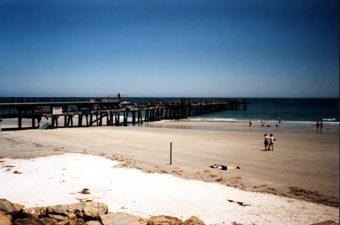
The old Brighton jetty after the 1994 storm (SR)
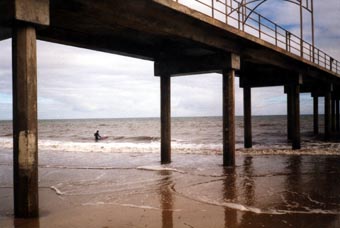
The new reinforced concrete jetty at Brighton (SR)
One year later
more storms added further damage to the jetty. There were winds of 120kph in
May 1995 and two similar storms in July 1995 (100kph on 13th July
and 128kph on 30th July). A new $2m reinforced concrete jetty had to
be built on the same site. Built by York Civil, it was completed in 1996. This
new jetty is 209m long and 4.9m wide. It is 4.85m above sea level. It has an
octagonal-shaped centerpiece and a T-shaped end. It also has a larger-size
shore end connection and there is a high telecommunications tower on the
seaward end of the jetty. A ceremony was held on 1st June 1996 to
mark the initial completion of the jetty. It was a cold, wet day but some 400
people were present for the ceremony. Following the completion of the tower and
beautification works by the Brighton Council, a special “opening ceremony” was
held in October 1996.
Jetties At Robe
Robe’s first
jetty was built by a George Ormerod in 1855. It was 91.5m long and it ran out
from a large cave on to a semi-circular beach. The cave was used as a storage
shed. A second jetty 91.5m long was built by Custance and Hackley about the
same time. It was extended at some stage but this jetty only lasted eleven
years. A third
jetty was built
between 1866 and 1868. It was demolished in 1951 after a fourth jetty was built
in 1949/50. I didn’t realize this when I wrote my article “My Continuing
“Encounter” Experiences” which was published in our 2004 MLSSA Journal. In that
article I had suggested that the present Robe jetty had been built in 1866 (the
year that construction had started on the third jetty).
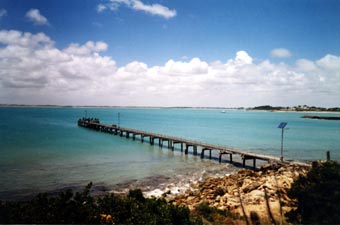
The present jetty at Robe (NR)
Old American River
Jetties
There is a
walking trail at American River on Kangaroo Island. The American River Heritage
Trail has interpretive signage. One of these signs gives details of jetties
built in the area. It says that the first jetty built there was known as
Buick’s Landing. This was built of logs laid side by side. Another jetty was
built in 1908 by volunteers who worked the piles into the sand by hand. “Hart’s
Jetty” was 32.6m long. A Government ‘T’ shaped jetty 46m long was built on the
same site in 1918. This jetty was then converted into a wharf in 1964. It then
became known as Hart’s Landing. A 45m-long jetty was then built and connected
to the wharf by two walkways.
Another one of
the signs on the walking trail gives details of another jetty built in the
area. The Fishermen’s Jetty was built by local fishermen in the 1930s. There is
a picture of it on the interpretive sign which says that the small jetty was
dismantled in the 1960s.
Balgowan Jetties
Two old jetties
built at Balgowan on the Yorke Peninsula turned out to be useless. The first
one was built in 1888. It was 36.5m long and it was built almost on the top of
a reef. A second jetty, 116m long, was built in a different location in 1907.
Severe storms reduced its length and it was eventually destroyed during a storm
in 1981.
Shortened Jetties
There are
many cases of long jetties being shortened, the Marion Bay jetty on the Yorke
Peninsula for example.
Marion Bay Jetty
Neville
Collins says that the Marion Bay jetty was constructed in 1889 and then
lengthened (from 151m) to 578m in 1927. The jetty was handed over to the
Department of Marine and Harbours in 1930 when the gypsum operations ceased at
Marion Bay. The jetty has now been shortened to just 267m.
Port Rickaby Jetty
The Port Rickaby
jetty on the Yorke Peninsula was built between 1878 and 1879. It was 123m long
but it was extended another 4.5m in 1881. It was then further extended in 1949
to 282m. The outer half of the jetty was demolished in 1966. The remainder of
the jetty became unsafe and in need of repair. As mentioned earlier, material
from the recently demolished Port Minlacowie jetty was used to repair it. The
length of the jetty is now just 114m.
Largs Bay Jetty
The first pile
for the Largs Bay jetty on the Lefevre Peninsula was driven on 12th
January 1882. It was being built under an eight-month contract and was opened
on 23rd December 1882. It was 640m long altogether. The first 564m
were 7.3m wide. For the last 76m (the seaward end) it was 15m wide. The extra
width was necessary to provide for trains to be able to shunt on the extra
lines whilst mailbags were being loaded on to mail vans. Rail tracks were laid
on the jetty in 1883. A severe storm in 1953 damaged the jetty which was
repaired in 1956. The outer end of the jetty was demolished and later replaced.
The new outer end started at the 137m mark. It was 3.6m wide for the first 201m
and the remaining 24m was 7.3m wide. A solid rock causeway replaced the first
six bays in 1970. The length of the jetty is now just 335m.
Semaphore Jetty
The Semaphore jetty
on the Lefevre Peninsula was opened in 1860. It was 561m long with an ‘L’ head.
It was later extended to 670m in length, including a new ‘L’ head. A cutting
through the sand dunes was made to the jetty. The cutting was named Jetty Road
at the time but the road has since become Semaphore Road. Baths were built at
the jetty in 1888 but these were destroyed in a storm on 17th July
1917. The storm also damaged the jetty then. The jetty gradually became shorter
and shorter over the years due to storm damage. A storm in 1994 reduced the
length of the jetty to 462m.
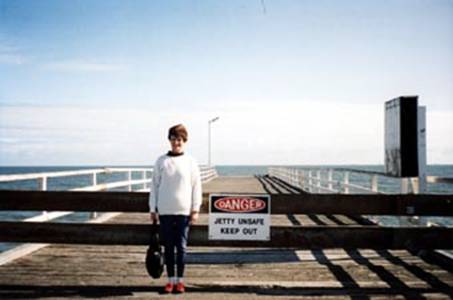
The Semaphore
jetty after a storm (SR)
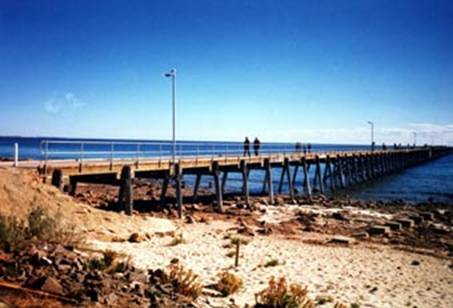
The Port Hughes jetty with concrete blocks
on the right (SR)
Port Hughes Jetty
The Port Hughes
jetty on the Yorke Peninsula was a bit of a latecomer, having been completed in
1913. This was much too late for it to have experienced any major trade. Its
original length of 430m has been reduced to the present length of 417m. On the
beach at the right of the jetty is a single row of concrete blocks leading into
the water. I don’t know what they were for. There seems to be a post on the
beach that is in-line with the blocks.
Not far from the
jetty are some rail tracks going into the sea. These are near a small
breakwater at the Port Hughes marina. Locals told me that the tracks were used
for rail trucks loading grain on to boats for delivery to ships anchored
offshore. I recently took another look at the rail tracks and they appear to
have possibly been part of a slipway.
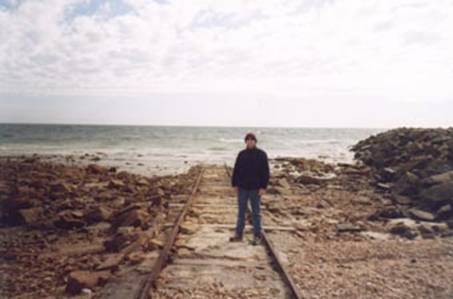
Rail tracks going into the sea near a
small breakwater (NR)
REFERENCES:
“The Glenelg Jetty” by Steve
Reynolds, MLSSA Newsletter June & July 2002, Nos.289 & 290.
“The Rise and Fall of the Semaphore
Jetty” by Steve Reynolds, MLSSA Newsletter August 1993, No.192.
“Semaphore Jetty” by Steve Reynolds,
MLSSA Newsletter November 1992, No.184.
The pamphlet “Reeves Point Historic Site”
(Government Printer, SA).
“Southern Passages” by Ronald Parsons
(Wakefield Press, 1998).
The pamphlet “South Australia’s Yorke
Peninsula, Unlocking the secrets – Historic jetties”.
“Yorke Peninsula . . . A Resident’s Views” by
Allan Parsons, second edition 1987, National Library of Australia ISBN 1 86252
059 2.
“A Story of Coobowie, Edithburgh and
District” published by the Edithburgh Museum Committee, 1986.
“The Story of Victor Harbor” by AA
Strempel & JC Tolley, Ambrose Press, reprinted 1979.
Friends of Port Moorowie web site http://www.netyp.com/member/moorowie/ .
“A Cruising Guide to Historic Gulf Ports –
Vol.1 (Gulf of St Vincent)” by Graham Scarce, Kingsley Publications, 1985.
“A Cruising Guide to Historic Gulf Ports –
Vol.2 (Investigator Strait and Kangaroo Island)” by Graham Scarce, Kingsley
Publications, 1985.
“The Changing Role of South Australian Jetties
1859-1959 – A comparative sample” by Mary Fencak (Thesis for Honours degree of
Bachelor of Arts in Flinders University) 1999.
Ships Graveyards web site
http://www.environment.sa.gov.au/heritage/ships_graveyards/pt_adelaide.html .
“South Australia – What’s in a Name?
(Historically significant place names) by Rodney Cockburn, Axiom Publishing,
1999. ISBN 0 9592519 1 X.
“The Jetties of South Australia – Past and
Present” by Neville Collins, published by the author, 2005. ISBN 0-9580482-2-3.
“Souvenir of the Edithburgh Jetty
125th Anniversary 1873-1998 25th and 26th
April 1998, History of Edithburgh Industry, Salt – Grain – Gypsum” by Jarrod
Thompson, Edithburgh Museum, 1998. ISBN 0 646 35330 6.